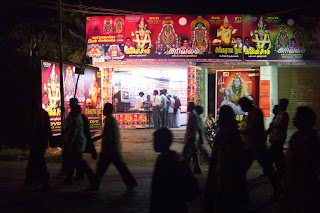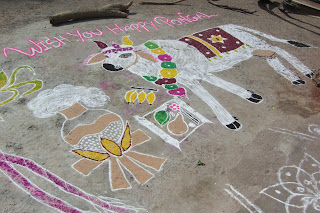I'm currently reading a pretty good book entitled
Cambodia Now, by Karen Coates, a journalist from the U.S. who worked as a reporter for a local English-language newspaper in Phnom Penh for a few years. It's a depressing read covering lots of current events, but it made me realize that of all the glowing things I've said about Cambodia, I hadn't yet talked about the negative. Unfortunately, in a country of such incredibly friendly people, the actuality of daily life and all the ills that stem from the
OUTRAGEOUS government corruption shouldn't put a smile on ANYONE'S face.
Quote from the Harvard International Reviw, speaking about aid money -
The programs would have provided employment and aid for thousands of impoverished people, as the World Bank acknowledged. But World Bank officials claimed they could not risk having the aid money end up in the hands of wealthy government officials, who apparently did not heed their lesson in 2003. As Khem Sokha, president of the Cambodian Human Rights Commission, explained, "The money received from the World Bank was intended for the many poor who lack sufficient food, water, shelter, and other most basic needs, not for the villas, land cruisers, and mistresses of some officials." The corruption of a few has led to a national crisis, and Cambodia's economic state is continuing to decline at a dangerous rate. The poor, not the POOR poor, that we interviewed with Maxima (during our work as Kiva Fellows) seem to have pleasant village lives despite living with only the basics. There are SCORES of people though that are forced to live on the edge of survival here (35% of the population lives below the poverty line), not knowing where their next meal will come from and having no home to call their own. What's tragic about all this is that there's ALOT of money flooding in to this country through tourism, especially
entrance fees to Angkor (One million visitors a year times $20 per day or $60 per week, totalling $1.3 billion USD!), though the government isn't the one footing the bill for restoration work (Japan, France, etc. are). Other countries are also footing the bills for extensive road improvements and other developments as they vie for rights for other things (possibly oil that has been discovered off the coast + in the Tonle Sap). Most of the human assistance here happens thanks to a slew of international NGO's, but even that doesn't ensure the money is going to those who need it. Besides the money factor, improvement in Cambodia (and the allowance of government corruption) is hindered by a variety of other factors -
LACK OF EDUCATION
It's A BIG problem in a country where most had no access to it during the Khmer Rough Regime. Many we've met are illiterate and can not afford to send their own children to school past the eighth grade, while some still don't understand it's importance. Also, they're uneducated about basic human rights that they DESERVE. (Photo below: Public awareness campaign poster against burning)

LACK OF WORK
There is an apparent lack of available work, especially for those with no capital or education. And even with a job - whether it be teacher, food vendor, construction laborer, loom weaver, city garbage collecter and even some doctors - it's only possible to earn $1-2 a day! That's BARELY enough for most people JUST to get by, and not enough for most to improve their lives. I'm not sure what it's going to take for this newly educated generation to be able to work their way up the economic + social ladder.
KARMIC ACCEPTANCE
Theravada Buddhism offers rational explanations for previous + future lives, but doesn't really delve in to how to resolve dilemmas of this existence. The religion teaches it's devotees to take what comes, so that the act of living becomes somewhat passive. When hard times befall the people, they merely ask the monks to pray to relieve them of the evil spirits. Now too, some become monks only to wear the robes so that they can ask people for money. They even smoke, drink, gamble + hire prostitutes undermining people's faith in them as someone they can go to for guidance. (Photo below: Taken by our expat friend,
Steve)

NO DEMOCRACY
The ruling political party (CPP) keeps their authority through falsifying elections and outright assasination of those that challenge them. This is even evident in the trials of the current Khmer Rouge leaders that have taken YEARS to prosecute those that ordered/participated in murdering 20% of their countrymen + women. Many people feel that they have no control over the political outcome of their country.
LAND OWNERSHIP
Records were destroyed during the Khmer Rouge regime and in 1979 land-grabbing became a free-for-all. Some people staked out plots for decades, securing them the rights to that land. Today, the rich and powerful take what they want, evicting those beneath them on the social scale to general acceptance. Many of these people are forced to migrate to Phnom Penh in search of work, or in times of flood or famine, living on the streets or building shanties. The government tries to hide the poverty, and it's part in perpetuating it, under a thin veil called "improvements", just so that it's not as obvious to the casual visitor. Ultimately, it's the powerful again who
take what they want by any means necessary. Check out
Darin's blog for a recent example we witnessed.

LACK OF SANITATION
Just 31% of Cambodians have access to clean water and a mere 15% to sanitary toilets (the style of which hasn't changed mush in 700 years). Most people are uneducated about waste disposal and how germs spread. Even now, sewage remains untreated and flows through open sewers, dumping into rivers which people downstream use as a water source. Those with no option but to live along the sewers suffer from a variety of related illnesses which they are to poor to seek treatment for. (Photo above: Roadside garbage, a common sight)
LACK OF HEALTHCARE
Most can not afford to treat their illnesses. Also, a variety of drugs which have been banned in the West are shipped off to poor countries (like Cambodia) and still readily available on the market, worsening the problem. Currently, the average life expectancy is only 61 years.
VIOLENCE
It goes back centuries. See the bas-reliefs at Angkor depicting ghastly scenes of battle and torture. More recently, the Khmer Rouge and the now-ruling CPP party. It's historically been condoned if done by the ruling elite to the poor, because of the class system. Now, even though they rule, police and other authorities are all known to be corrupt and not trusted so occasionally people take justice in to their own hands with mob beatings for offenders. (Photo below: Khmer Rouge genocide memorial)

THE STATUS OF WOMEN
It's a generally accepted view that a woman's place is in the home or at the market, and that her husband may do as he will. If not this, then she must be young, beautiful, and give herself to men. Women are just now beginning to understand that they have rights too and there are highly visible ad campaigns now telling women to say no to domestic violence.
THE STATUS OF CHILDREN
Approximately 500-1,500
kids live on the streets of Phnom Penh with their families (as of 2003), another 1,200 live alone, and 10,000-20,000 work on the streets selling books, postcards, candy, souvenirs, etc. Some children are sold for next to nothing by their parents because they can't afford to feed them. Some of these live a life working under a "Big Brother" who takes their earnings from selling things, and others are sold in to the sex industry to the highest bidder. Recently, the latter has been cracked down on, but if you've got the cash you can still get away with anything here. (Photo below: Public awarenesss campaign poster against domestic violence)

TOO MUCH AID
Many view Cambodia as a "beggar nation". Rich, donor nations pour money into causes they can feel good about with little concept of the culture here. The foreigners that come to work for NGO's seem to OOZE money in keeping with their western lifestyles. And the money keeps coming, year after year. The more problems Cambodia has, the more NGO's show up, the more money that comes. The people SEE this. The government SURELY sees this. Why should the government solve it's own problems when the foreigners can? Or will? And so Cambodia becomes a dependent nation. The government begs the world, the world gives, and the powerful take what comes. More and more money lines the official's pockets. The rich are rich and the poor are poor. And if you're rich, you must be doing something right to have that power, that good karma. Buddhism, the way that it is interpreted here, essentially tells the people so. Cambodia takes in $537 million (2005) of foreign aid a year, for more than a decade, but more than one-third of the population still lives below the poverty line.
VIEW OF THE FUTURE
As the gap between rich + poor continues to widden, and elections are falsified, the people have no faith that change will come from the inside. And with antiquated Buddhist beliefs, they continue to accept it. The feeling of hopelessness is heightened by the fact that the vast majority are so poor that they really just focus on the day-to-day challenges of having food and shelter.
Here's what the CIA's
World Fact Book has to add -
The major economic challenge for Cambodia over the next decade will be fashioning an economic environment in which the private sector can create enough jobs to handle Cambodia's demographic imbalance. More than 50% of the population is less than 21 years old. The population lacks education and productive skills, particularly in the poverty-ridden countryside, which suffers from an almost total lack of basic infrastructure. All that said, I DO love the country, but earnestly hope for needed changes there. There's a great blog I enjoy reading, written by an expat living in Phnom Penh. Check out his regularly updated blog at
Details Are Sketchy for a cynical view of current news in Cambodia relayed with humor.

































